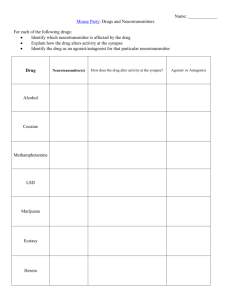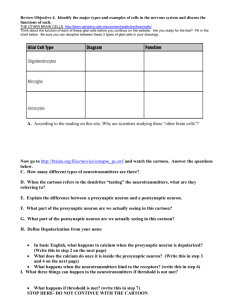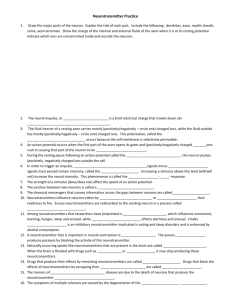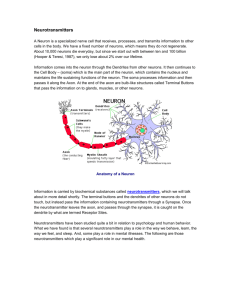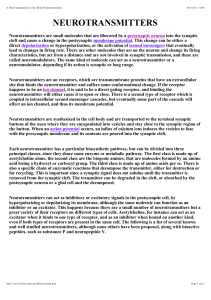BIOLOGY 12 TRANSMISSION OF IMPULSES ACROSS SYNAPSES
advertisement
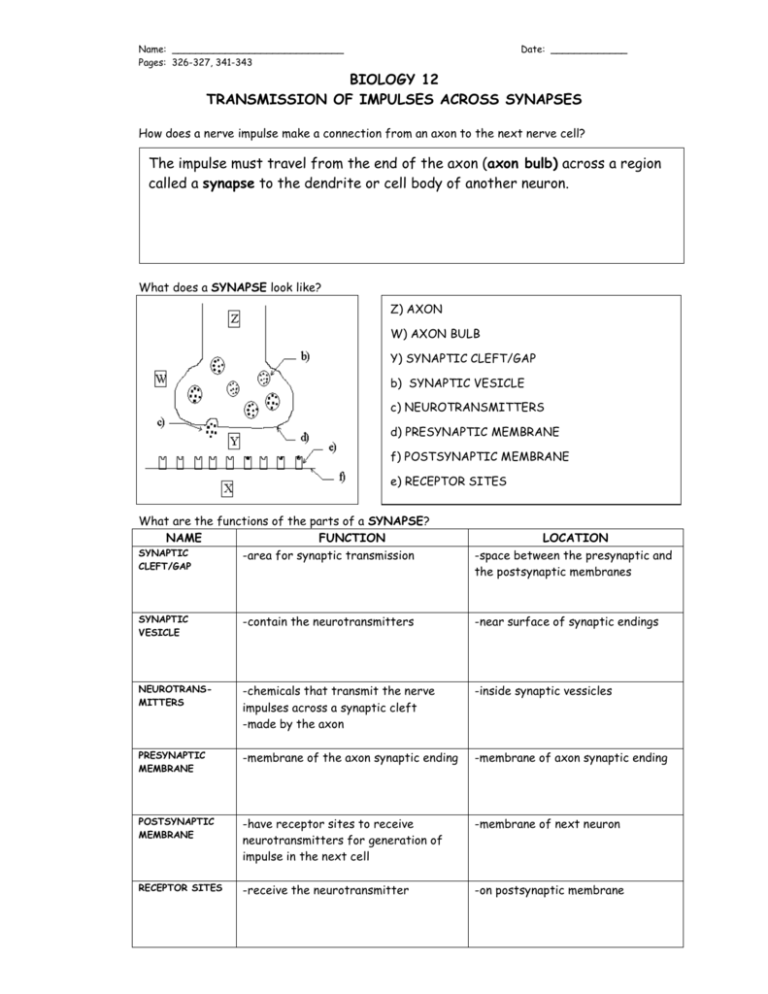
Name: _____________________________ Pages: 326-327, 341-343 Date: _____________ BIOLOGY 12 TRANSMISSION OF IMPULSES ACROSS SYNAPSES How does a nerve impulse make a connection from an axon to the next nerve cell? The impulse must travel from the end of the axon (axon bulb) across a region called a synapse to the dendrite or cell body of another neuron. What does a SYNAPSE look like? Z) AXON W) AXON BULB Y) SYNAPTIC CLEFT/GAP b) SYNAPTIC VESICLE c) NEUROTRANSMITTERS d) PRESYNAPTIC MEMBRANE f) POSTSYNAPTIC MEMBRANE e) RECEPTOR SITES What are the functions of the parts of a SYNAPSE? NAME FUNCTION SYNAPTIC -area for synaptic transmission CLEFT/GAP LOCATION -space between the presynaptic and the postsynaptic membranes SYNAPTIC VESICLE -contain the neurotransmitters -near surface of synaptic endings NEUROTRANSMITTERS -chemicals that transmit the nerve impulses across a synaptic cleft -made by the axon -inside synaptic vessicles PRESYNAPTIC MEMBRANE -membrane of the axon synaptic ending -membrane of axon synaptic ending POSTSYNAPTIC MEMBRANE -have receptor sites to receive neurotransmitters for generation of impulse in the next cell -membrane of next neuron RECEPTOR SITES -receive the neurotransmitter -on postsynaptic membrane What is the sequence of events in a SYNAPTIC TRANSMISSION? 1. Nerve impulse travel along axon, the axon bulb. K+ Na+ 2. Arrival of nerve impulse at the axon bulb changes membrane ----> Ca++ flows into ending Ca+ Ca+ 3. Ca++ ions cause contractile proteins to pull synaptic vesicles to inner surface of the presynaptic membrane. Ca+ Ca+ 4. Vesicle fuses with presynaptic membrane, releasing neurotransmitters into synapse. (EXOCTYOSIS) 5. Neurotransmitters DIFFUSE across synaptic cleft to receptors on postsynaptic membrane. The receptors control selective ion channels; binding of a neurotransmitter to its specific receptors opens the ion channels. 6. The resulting ion flux (not shown on diagram) changes the voltage of the postsynaptic membrane. The neurotransmitters binding to receptors on the dendrite causes the nerve impulse to be transmitted down the dendrite of the second neuron. The nerve impulse has now been transmitted from the first neuron to the second neuron. K+ Na+ 7. Neurotransmitters are quickly deactivated to prevent them from continually acting on postsynaptic membrane and for continuous stimulation or inhibition of postsynaptic membrane. K+ Na+ How are neurotransmitters deactivated? a) ENZYMES: degrade neurotransmitter (e.g., acetylcholinesterase (AChE) breaks down to acetycholine). b) REABSORPTION OF NEUROTRANSMITTER: synaptic ending reabsorbs the neurotransmitter for repackaging by synaptic vesicle or for molecular breakdown ( e.g. Serotonin; Monoamine oxidase breaks down noradrenalin after it is absorbed. More on neurotransmitters: Neurotransmitters take nerve impulses across synapses. They are small molecules (single amino acids, short chains of amino acids or derivatives of protein. Some of the messages are excitatory (i.e. they tell the neuron to “fire”) while others may be inhibitory (i.e. they tell the neuron not to fire). Whether or not a neuron “fires” off an action potential at any particular instant depends on its ability to integrate these multiple positive and negative inputs. A balance of neurotransmitters is important for proper brain and nervous system functioning. There are at least 25 different neurotransmitters that have been identified. DRUG ACTION AND NEUROTRANSMITTERS There are many drugs that are used to alter the mood and/or emotional state of the user. In general, mood-altering drugs particularly affect the RAS and limbic system, and they either promote or decrease the action of a particular neurotransmitter. There are basically 5 ways a drug can act: • • 4 1 2 3 5 The 5 ways that drugs can act at synapes! 1. 2. 3. 4. 5. drug stimulates release of neurotransmitter. drug blocks release of neurotransmitter drug combines with neurotransmitter preventing its breakdown drug mimics neurotransmitter drug blocks receptor so neurotransmitter can't be received These drugs can be as common as the caffeine found in coffee, or theophylline in tea (both block the action of adenosine, a chemical that inhibits the release of neurotransmitters). Nicotine enhances the action of acetylcholine. Some drugs (e.g. thorazine) also affect cognitive or thinking processes. Mood-altering drugs particularly affect the RAS. Drugs either promote or decrease the action of neurotransmitters, either stimulating or inhibiting the action of excitatory transmitters or inhibitory transmitters. Stimulants either enhance excitatory transmitters or block the action of inhibitory transmitters. Depressants either enhance the action of an inhibitory transmitter or block the action of an excitatory transmitter. Drug Action Type of Neurotransmitter Result Blocks neurotransmitter Enhances neurotransmitter Blocks neurotransmitter Enhances neurotransmitter Excitatory Excitatory Inhibitory Inhibitory Depression Stimulation Stimulation Depression THE ACTION OF DRUGS ON NERVOUS SYSTEM AMPHETAMINES - structurally similar to noradrenalin (NA), stimulates release of NA and dopamine in brain. e.g. cocaine blocks the uptake of dopamine so it is present in the synaptic cleft longer. As dopamine is an excitatory neurotransmitter, this causes the “rush” that cocaine users experience. Overuse can lead to hallucinations and other neurological effects (e.g. extreme addicts can lose the ability to feel pleasure). • METHAMPHETAMINE (Ice) has the same stimulatory effects as cocaine, but its effects last longer. • MARIJUANA (Cannabis sativa) leaves contain a resin rich in THC (tetrahydrocannabinol), which is marijuana’s active ingredient. It causes in many people a mild euphoria along with alterations in vision and judgment, which result in distortions of space and time. Smokers will often have a very hard time speaking coherently and concentrating. Like LSD, it is classified as a hallucinogen. It can be psychologically addicting. Marijuana may act on the neurotransmitter serotonin. • TRANQUILIZERS - e.g. Valium, Ativan, barbiturates, and alcohol enhance the action of the inhibitory transmitter GABA. Dependency develops when the body begins to produce less GABA on its own. Overall, tranquilizers depress brain function, and overdoses can cause death. • LSD - (lysergic acid diethylamide) - affects the action of serotonin and dopamine on RAS cells involved in vision and emotion -> produces visual and auditory hallucinations and bizarre sensory sensations. LSD can cause permanent brain damage! Never take this drug. • CAFFEINE - blocks the action of adenosine, a chemical that inhibits the release of neurotransmitters. Therefore, it acts as a stimulant • NICOTINE - enhances the action of acetylcholine. One of the most addictive compounds known. • ALCOHOL - enhances the action of the inhibitory transmitter GABA. Therefore it acts as a depressant. Dependency develops when the body begins to produce less GABA. Death can occur from over consumption because of its depressing effect on brain functions. Habitual use can also damage areas of the brain (especially the hippocampus, which can cause memory impairment). Also leads to cirrhosis. # of Blood ROH Level Effect drinks 1 0.02-0.03% Changes in behavior, coordination, and ability to think clearly 2 0.05% Sedation or tranquilized feeling 3 0.08 Legal intoxication in B.C. (it is lower in some other provinces) 5 0.15-0.20% Person is obviously intoxicated and may show signs of delirium 12 0.30-0.40% Loss of consciousness 24 0.50% Heart and respiration become so depressed that they cease to function and death occurs. • NARCOTICS such as HEROIN and MORPHINE block the transmission of pain signals, as they bind to receptors meant for the body's natural opioids (endorphins and enkephalins). Opioids are believed to relieve pain by preventing the release of a neurotransmitter (lets call it “P”) that causes the sensation of pain from certain neurons in the spinal chord. Heroin addicts become physically dependent on the drug. With time, the body’s production of endorphins decreases. Tolerance develops so that the user needs to take more of the drug just to prevent withdrawal symptoms. The euphoria originally experienced upon injection is no longer felt. Heroin withdrawal symptoms include perspiration, dilation of pupils, tremors, restlessness, cramps, gooseflesh, involuntary defecation, vomiting, and increase in blood pressure and heart rate. •



